The Chippy Gray Milk Paint Dresser
Create a yummy chippy painted finish on your old wood furniture with milk paint! Real powdered milk paint creates a farmhouse, old world, rustic look, but is unpredictable when it comes to chipping. Let’s dive into the chippy gray milk paint dresser makeover!
Get more gray painted furniture ideas here.

I’m not gonna lie. I’ve been in a bit of a funk lately. I’ve been having a hard time choosing colors for pieces, second-guessing my choices, and stewing for literally hours about what I want to do.
It’s nooo good.
And then I spotted the Shackteau Interiors Milk Paint that I recently bought, and I decided it was time to have a little bit of fun. It was time to go completely out of the norm.
I picked this dresser out of my inventory. I love the details on the top drawers and I really love the little legs.
Supplies Used for the chippy gray milk paint dresser:
As an Amazon Associate, I earn from qualifying purchases. I also may earn from other qualifying purchases with other companies or get free product to review and use. All opinions are my own.
- Shackteau Interiors Milk Paint in Magnolia Pier
- 80 grit sandpaper and 220 grit sandpaper
- Orbital Sander with 80 grit and 220 grit sandpaper
- Sander Deglosser
- Quality Paint Brush and Cheap Paint Brush
- Hemp Oil ( I used Country Chic Paint Hemp Oil because I had it on hand. Shackteau sells hemp oil as well!)
- New Hardware
Sanding the legs
The first thing I knew for sure was that I wanted the legs to have a farmhouse worn look.
I didn’t want to wait for the stripper to to do its work, so I went all in with sanding the legs down by hand.
Read this post to learn about the best Sandpaper for Furniture!
It took about 30 minutes to sand them both down by hand, so really I spent more hands on time sanding them down than if I would have used stripper on them.
I first used 80 grit sandpaper, and then I smoothed down the wood with 220 grit sandpaper.
You can learn more about how to sand legs down by hand right here!
Sanding the top
The old finish on the top was really rough and needed to be sanded down. And then we uncovered the coolest wood grain, so I didn’t want to cover it up with paint!

I used this orbital sander, first with 80 grit sandpaper and then 220 grit sandpaper.
Click here to learn more about the Best Sanders for Furniture.
* Note: The lower the grit number, the more rough it is, which means that it will take off an old finish a lot faster. The higher the grit number, the more smooth it is, which means that it will create a smooth surface.
How to Mix Powdered Milk Paint
Before I start to prep the furniture, I mix up a small batch of milk paint
This milk paint comes in a powdered form, so you have to mix it with water to create a paint. That’s one thing that makes it so unique and fun to work with.
Milk paint doesn’t last long once it’s mixed up, but has a very long shelf life in the powdered form. So you’ll want to mix up small batches, and only what you will use for the day.
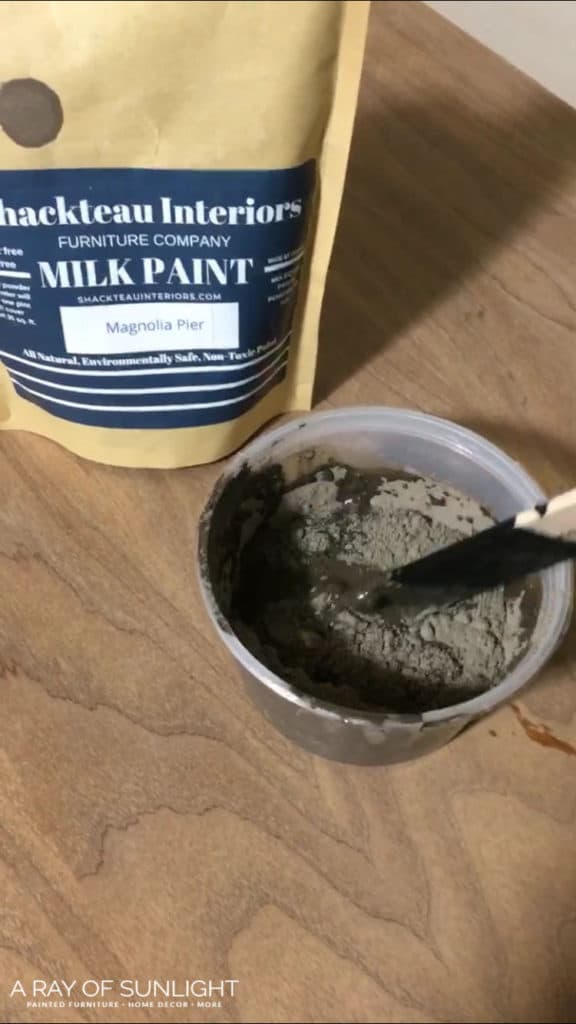
The recipe calls for a 1:1 ratio of paint powder to water.
I measure out the amount of milk paint that I need into a clean container, and then mix in the same amount of warm water.
A small whisk works really well for mixing the powder and water together to create a super smooth consistency.
No need to buy special containers to mix the paint in.
Personally, I like to save old food containers like pasta sauce jars, sour cream, and yogurt containers after they are empty. Then clean them out and use them for mixing paint.
Once the paint is mixed up, I cover it and let it sit for at least ten minutes. That extra time will create a smoother consistency and thickens up the paint a bit.
After I let it sit, if it’s too thick for my liking, I add a little bit of water to the paint.
There is nothing wrong with thickening it up or thinning it out to create the thickness that you like!
Just add more powder to thicken it up, or add more water to thin it out.
Learn more about How to Mix Milk Paint here.
How to Prep Wood Furniture for Milk Paint
While the milk paint sits for a bit, it’s time to prep the furniture.
For this dresser I wanted to create a chippy look, not too much chipping, but I also didn’t want the paint to completely stick and not create any chipping.
In theory (milk paint really has a mind of its own though), milk paint will soak into raw wood.
When it soaks in, it will bond to the wood and create a full coverage finish.
If the milk paint doesn’t have much to stick to, it will start chipping off once it dries.
So if you want it to stick to your furniture (and not chip), it’s best to scuff sand it really well with 220 grit sandpaper and mix some Extra Bond into the first coat of paint.
Click here to learn more about the importance of Sanding Before Painting Furniture.
BUT… If you want it to really chip, it might be best to not scuff sand it.
That’s not always a guarantee though, depending on how glossy or dry your wood furniture is to begin with.
Glossy surfaces will always resist paint. That is why we always scuff sand on our usual prep.
Learn more about how we typically prepare furniture before painting here!
Dry wood is ready to soak in anything that it comes across, just like raw wood, so scuff sanding isn’t as important.
I hesitate to say that because with normal paint, I always scuff sand, even if the paint says it will adhere without sanding. But milk paint seems to be in a category of its own.
Since I wanted something right in the middle, (the wood on this piece was dry in some places, shiny in others, and rough in others) I decided to try using the Sander Deglosser, hoping that it would create some areas where the paint would stick, and others where it wouldn’t.
I put on plastic gloves, poured a little bit on my old rag, and then wiped it onto the dresser.
Then I let it dry completely.
Thankfully it worked!
How to Paint with Milk Paint
I painted on two coats with a Paint Brush, letting each coat dry completely.
Click here to learn all about The Best Paint Brushes for Painting Furniture!
After the first coat of paint, there was a good amount of chipping! I was so excited to see what would chip. I also wanted to smooth the paint a bit, so I started sanding.
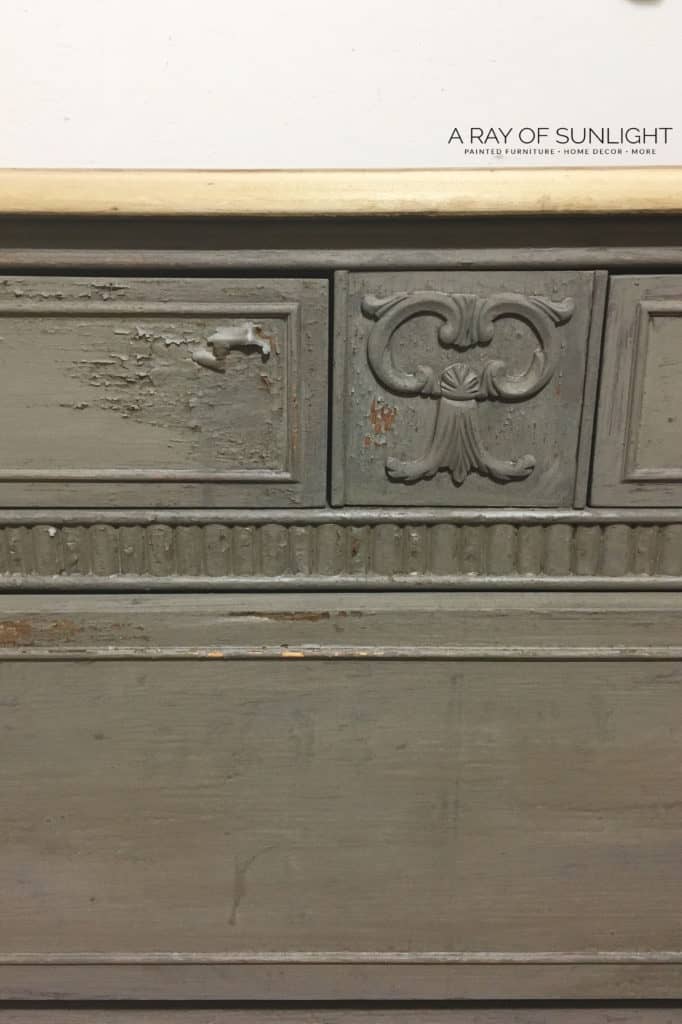
Next time though, I don’t think I will mess with the chipping or sanding until the 2nd coat is dry.
Otherwise, the spots where it chipped and I went over it with the sandpaper, only got one coat of paint, and it looked streaky in those areas until I put another coat on them.
When the second coat was drying I took my hair dryer (on its hottest highest setting) and tried to quickly dry certain areas, creating more chipping in that area.
In some places it worked really well, in others the paint wouldn’t chip at all!
Read through this post to learn more about how to use milk paint on furniture.
Get more Milk Painted Furniture ideas here for your next painting project.
Chippy Paint
When all the milk paint was dry, I rubbed off the chipping paint, sanded the finish down a bit smoother, and wiped off all the chipping and dust with a tack cloth.
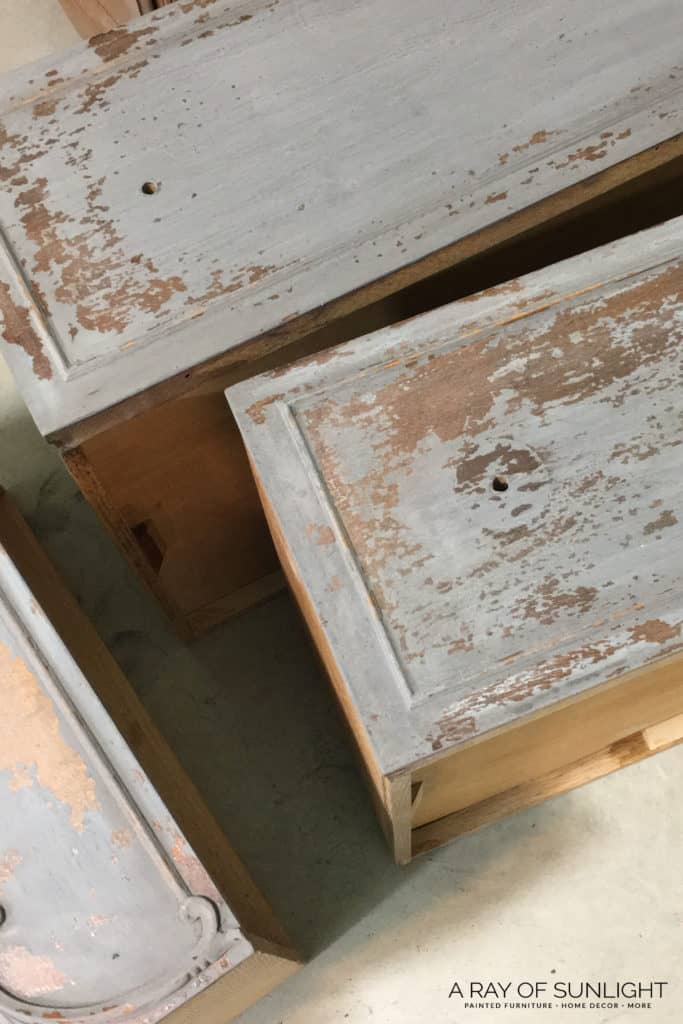
How to Seal Milk Paint
On this dresser, I used Hemp Oil all over it. On the top, the legs, and over the milk paint.

Hemp oil is a little different than what I usually use for a topcoat.
Learn all about the different Topcoats for Painting Furniture here!
I brushed it on and walked away for about 6 hours. Then I wiped off all of the excess that didn’t sink into the wood and paint.
Then I put another coat of hemp oil on, and repeated the process of waiting for it to soak in, and then wiping off the excess.
Since it was the weekend, I let the hemp oil dry for a couple of days until I got back to work.
Learn more about how to seal milk paint here.
The New Hardware
We finished it off with some clear knobs from D Lawless Hardware.
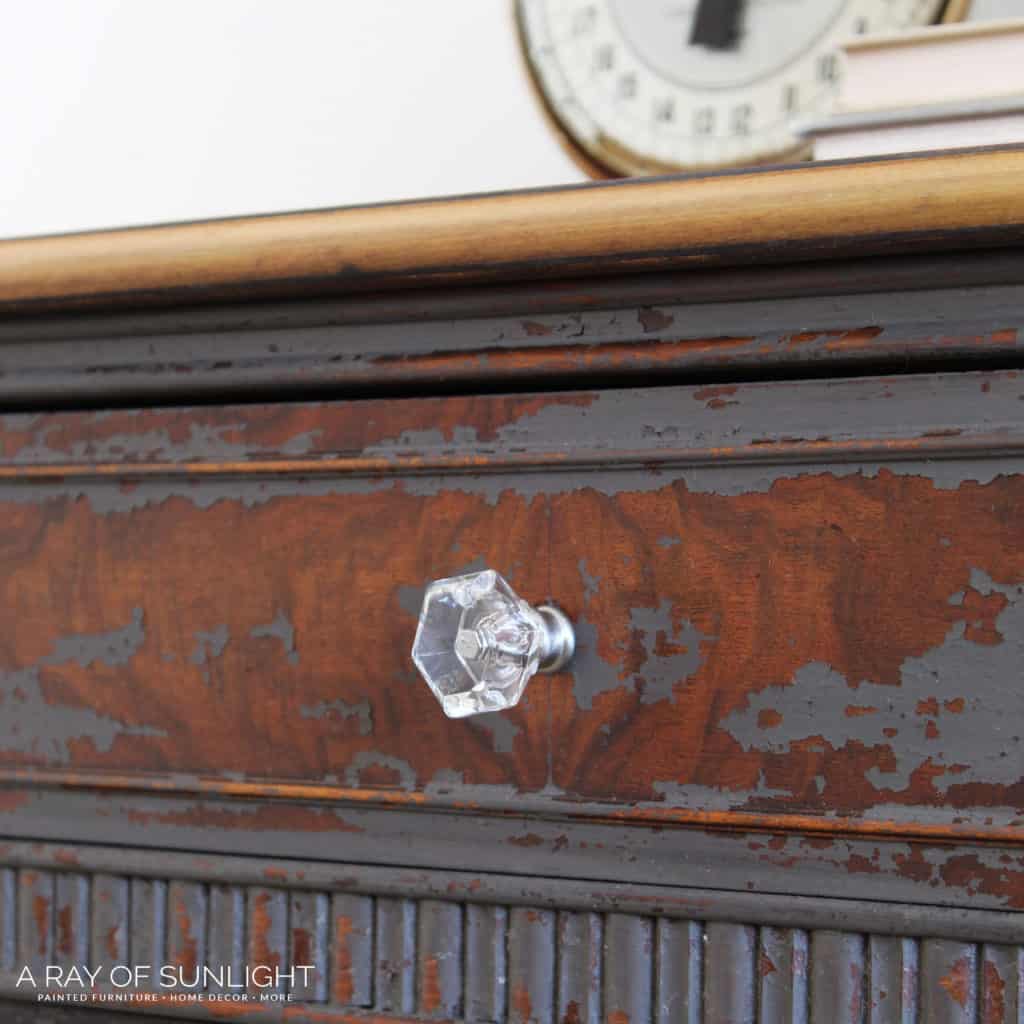
If you’re wanting to have some fun with paint and old furniture, I think you’ll like Milk Paint.
It’s not my usual style of finish, but I had a blast and it was so much fun to look forward to how much it was going to chip.
Head on over to our Rustic Painted Furniture ideas for your next project.
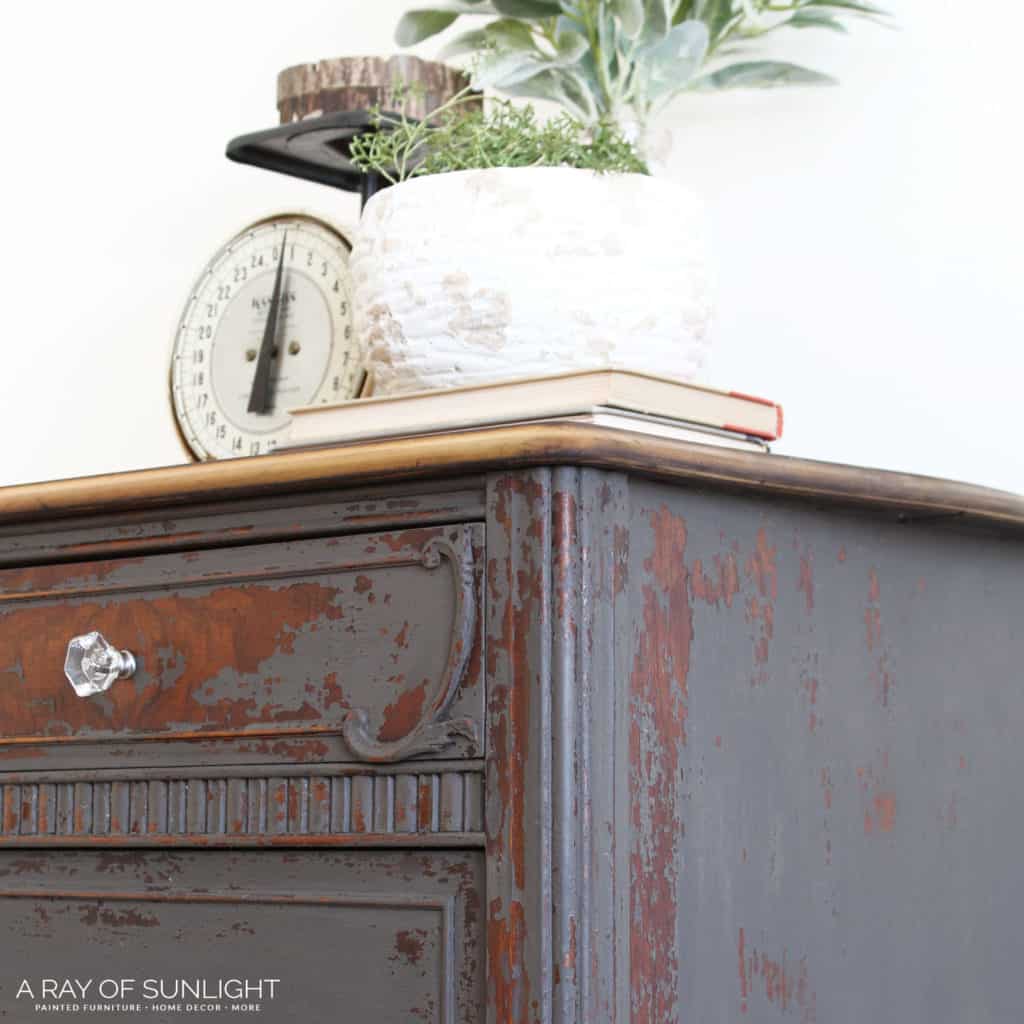


More Milk Paint Makeovers:
- Navy Blue DIY Dresser Makeover
- Chippy Blue Painted Hutch Makeover
- Dark Green Buffet Makeover
- Repurposed Sewing Table
- Painted Display Cabinet: Before and After
Follow us on YouTube to get more tips for painting furniture.
Or share your project with us on our Facebook Group and be part of our community. See you there!

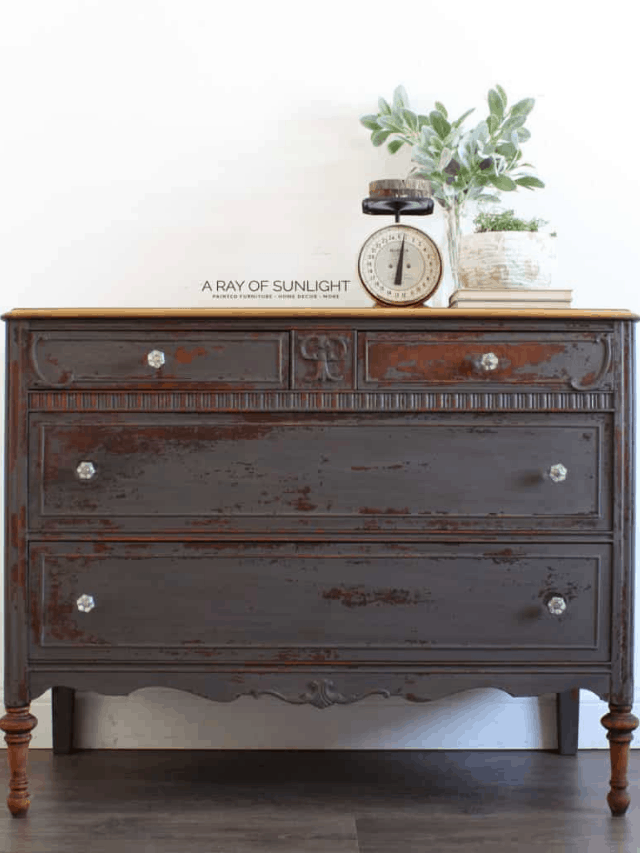



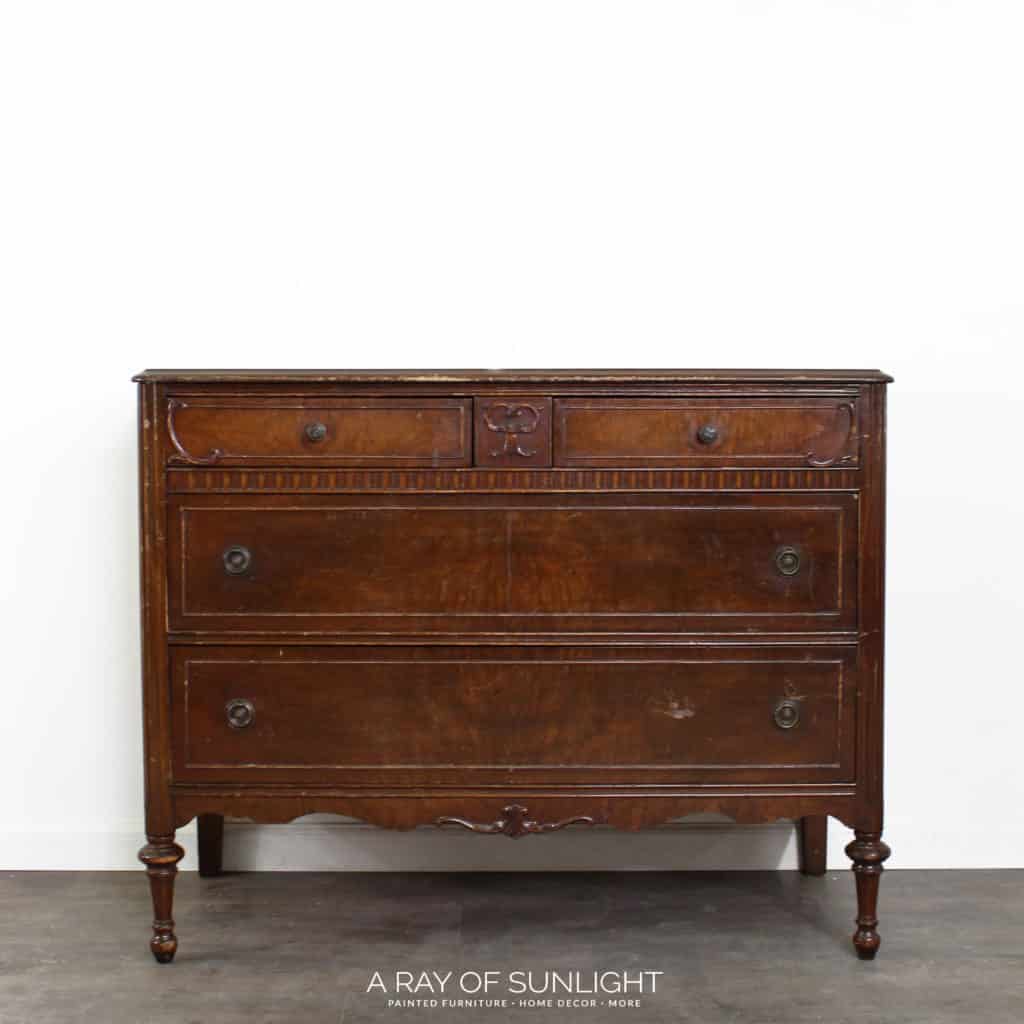
I think it’s got character, and is beautiful!
This turned out gorgeous! I just bought some milk paint and am super excited to try it myself after seeing this. 🙂
L LOVE this chippy paint finish. That’s my kinda furniture.
Natalie,
You’re skill and a few possible happy accidents expected with milk paint make this the mostly beautifully executed piece of milk paint furniture I’ve seen.
Ever. It’s a vision!